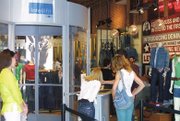Levi's Technology Test Draws Crowds
San Francisco–based Levi Strauss & Co. is hoping some new technology can help boost sales and improve customer service.
The company this week installed a 3-D body scanner in its Santa Monica Promenade store in Santa Monica, Calif., as part of an experiment to see if the technology could help customers attain a good fit as well as stir up some business. Levi’s business has been strong internationally but remained flat in the United States during the past year, so improving customer service may be a shot in the arm.
The space-age body digitizer Levi’s is experimenting with has certainly attracted lots of attention. The company has shuttled it through New York, Chicago and Dallas, in addition to Santa Monica. The digitizer will head to San Francisco’s Union Square on May 15 and then to Portland, Ore.; Seattle; and Miami. At the Levi’s store in New York’s SoHo district, the lines were two hours long at times, said company officials. At Santa Monica this week, the lines were not as long but did provide a spike in traffic.
“It has helped to increase foot traffic,” said Kathryn Mauldhart, a fit expert with Levi’s. “I see lots of benefits to this. People come in, get scanned, try on some jeans. They fit great, and they’re happy.”
The scanner, provided by Horsham, Penn.–based Intellifit Corp., uses radio waves from a rotating wand that measures fit at more than 200 points on the body. The scan takes about 10 seconds, and a couple minutes later, customers get a printout providing size recommendations for a number of Levi’s styles, including the 501, 505 and 550 looks. Because Levi’s produces a variety of cuts, fits and styles, different sizes for the same person may be recommended. At the Santa Monica demonstration, customers were provided with personal shoppers to help them with their purchases.
For the most part, the scanner provided accurate readings, according to Levi’s officials, though some customers said some of the waist measurements they received were too big.
One reason for this might be because the scanner scans horizontally, taking measurements of the body profile at its widest point. Some consumers prefer to wear their jeans slightly below the waist, making for a smaller measurement.
Levi’s officials will consider whether to deploy the scanners on a permanent basis after the demo tour. Regardless of what happens, fit will continue to be an issue with consumers.
“People are confused. There are so many brands now. They’re overwhelmed. We wanted to take a leadership role with this,” said Levi’s spokesperson Amy Gemellaro. “Women and men are buying denim for every occasion now. They have a Saturday jean, a casual jean, so they want the best fit. We see women going into dressing rooms with 15 pairs and coming back with one that may fit. With the Intellifit, we want to make the process of making their decisions easier.”
Until recently, body scanners have been the domain of researchers and manufacturers. Los Angeles companies Shapely Shadow Inc. and Tukatech Inc. use laser light scanners, while Video Measurement System (VMS) uses video cameras to record measurements. North Carolina’s TC2 also has a system. The scanned data is utilized to produce body forms and 3-D virtual models for fittings, computer-aided design and other applications.
The scanners, which can cost up to $400,000, can be a big expense for retailers, although some suit shops are using them for made-to-measure business. At least one Macy’s store is using body scanners, said Levi’s officials.
Intellifit has placed the scanner with Lane Bryant and David’s Bridal. This July, the company will stage its product at several Westfield and General Growth Properties malls. “This way, the stores only have to pay a small fee,” said Intellifit President Ed Gribbin.
Companies such as VMS hope to bring more affordable machines to the market. The company is currently seeking investors so it can roll out the product on a more broad-based level.
Intellifit’s system was originally developed as a security device for use at airports but ran into privacy issues because it created a full body hologram. —Robert McAllister






















